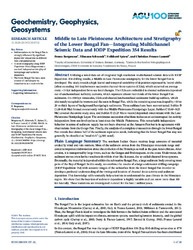Middle to Late Pleistocene Architecture and Stratigraphy of the Lower Bengal Fan—Integrating Multichannel Seismic Data and IODP Expedition 354 Results
Bergmann, Fenna
Schwenk, Tilmann
Spiess, Volkhard
France-Lanord, Christian
DOI: https://doi.org/10.1029/2019GC008702
Persistent URL: http://resolver.sub.uni-goettingen.de/purl?gldocs-11858/9196
Persistent URL: http://resolver.sub.uni-goettingen.de/purl?gldocs-11858/9196
Bergmann, Fenna; Schwenk, Tilmann; Spiess, Volkhard; France-Lanord, Christian, 2020: Middle to Late Pleistocene Architecture and Stratigraphy of the Lower Bengal Fan—Integrating Multichannel Seismic Data and IODP Expedition 354 Results. In: Geochemistry, Geophysics, Geosystems, Band 21, 1, DOI: 10.1029/2019GC008702.
 |
Dokument öffnen: |
Utilizing a novel data set of integrated high-resolution multichannel seismic data with IODP Expedition 354 drilling results, a Middle to Late Pleistocene stratigraphy for the lower Bengal Fan is developed. The study reveals a high lateral and temporal variability of deposition expressed by lateral shifts (often exceeding 100 km) between successive channel-levee systems (CLSs), which occurred on average every ~15 kyr independent from sea-level changes. The CLSs are embedded in sheeted sediments deposited out of unchannelized turbidity currents, which represent almost two thirds of the lower Bengal Fan sediments. On 100-kyr timescales, CLSs and sheeted/unchannelized sediments build up subfans, which alternately occupied the western and the eastern Bengal Fan, while the remaining area was draped by ~10 to 20 m-thick layers of background/hemipelagic sediments. Three subfans have been reconstructed: Subfan B (1.24–0.68 Ma) formed concurrently with the Middle Pleistocene Hemipelagic Layer, Subfan C (0.68–0.25 Ma) covered the entire study area, and Subfan D (0.25 Ma to recent) deposited concomitant with the Late Pleistocene Hemipelagic Layer. The continuous succession of subfans indicates an uninterrupted fan activity independent from sea-level cycles at least since the Middle Pleistocene. This remarkable independent behavior in terms of sediment supply has not been observed at the Amazon Fan but is in agreement with observations from the Congo Fan. Finally, the analysis of a complete cross section through the lower Bengal Fan reveals that almost half of the sediment represents sands, indicating that the lower Bengal Fan may not generally be classified as “mud rich” (≤30% sand).
Statistik:
ZugriffsstatistikSammlung:
Schlagworte:
Bengal FanChannel-levee systems
High-resolution multichannel seismics
IODP Expedition 354
This is an open access article under the terms of the Creative Commons Attribution License, which permits use, distribution and reproduction in any medium, provided the original work is properly cited.

